Home » Scholar »
Ancient Authors
ANCIENT AUTHORS

Click on objects on the picture to see larger images
Like other young classicists, Kelsey began his scholarly career by publishing texts of ancient authors.
His first contribution (published in 1882) was a revision of James Reid's edition of Cicero's Cato Maior and
Laelius. Kelsey reshaped Reid's book, writing a long introduction and including copious notes addressing the
literature's contexts. This text was followed in 1884 by his edition of De Rerum Natura by Lucretius.
Then came the text for which he is best known, Caesar's Gallic War, first published in 1886 and revised throughout
his life. By the time of his death in 1927, 21 editions had appeared. Introduction, notes, and vocabulary are extensive.
Illustrations, bringing to bear new technologies, included maps, partially colored plans, and color plates. In 1918 this
book morphed into Caesar's Commentaries, a volume almost as influential as the Gallic War.
The first edition of yet another textbook, Xenophon's Anabasis, written and edited with a colleague at Lake Forest, Andreas C. Zenos, came out in 1889. In emphasizing contexts, it followed the pattern of the other textbooks.
-

F. W. Kelsey, Caesar's Gallic War (1897)
F. W. Kelsey, Caesar's Commentaries, text edition (1918)
F. W. Kelsey, T. Lucreti Cari: De Rerum Natura (1892)
F. W. Kelsey, Selections from Ovid (1891)
Buhr Storage Facility, The University Library
-
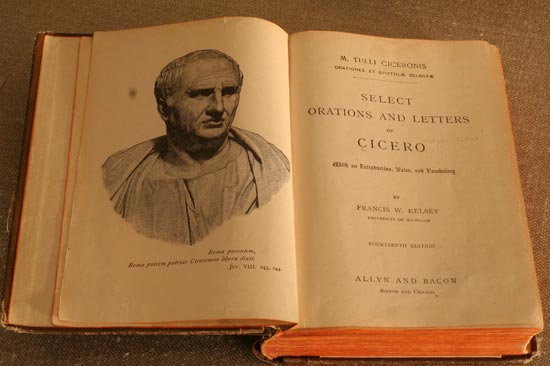
F. W. Kelsey, Select Orations and Letters of Cicero (1905)
Buhr Storage Facility, The University Library
-

Frontispiece from F. W. Kelsey, Select Orations and Letters of Cicero (1905)
Buhr Storage Facility, The University Library
-

F. W. Kelsey and A. C. Zenos, Xenophon's Anabasis (1889)
Buhr Storage Facility, The University Library
-
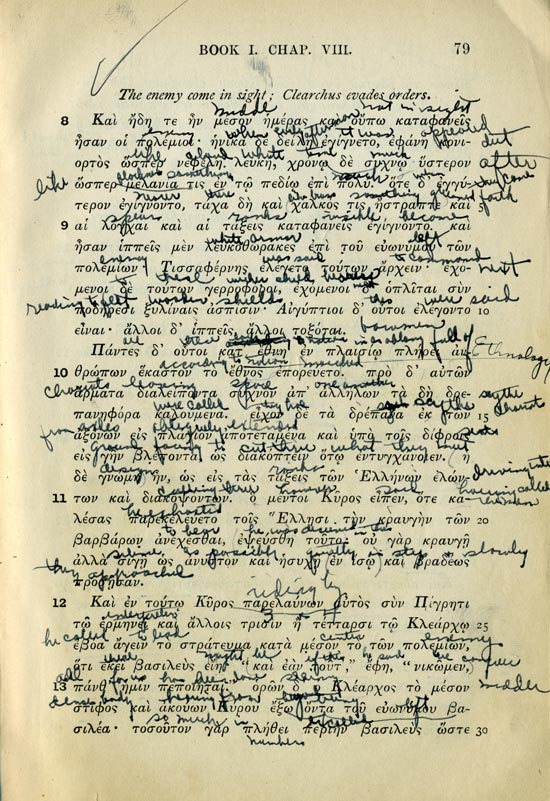
Text from F. W. Kelsey and A. C. Zenos, Xenophon's Anabasis (1889), with a student's notes
Buhr Storage Facility, The University Library
-
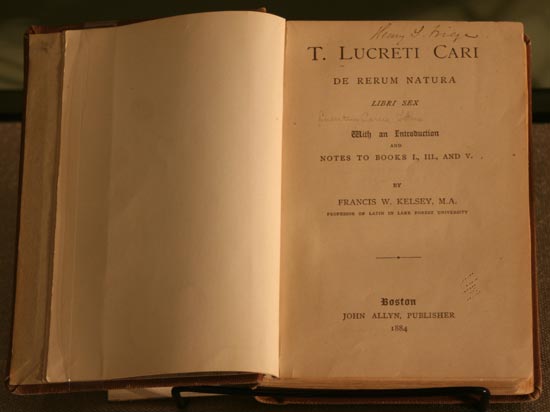
F. W. Kelsey, T. Lucreti Cari: De Rerum Natura (1884). This copy belonged to
Henry Simmons Frieze, the chair of the Latin Department who hired
Kelsey and served three times as acting president of the University of Michigan
Buhr Storage Facility, The University Library
-
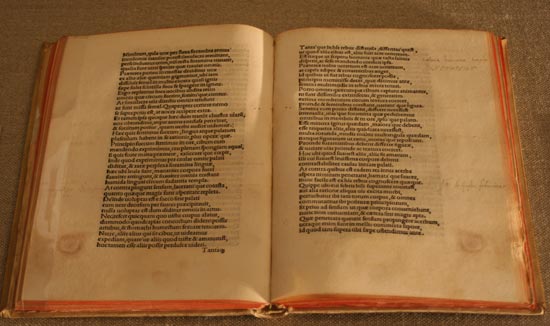
De rerum natura, Titus Lucretius Carus (ca. 99– ca. 55 bc), Ed. Hieronymus Avantius (fl. end of 15th century),
Venice: Aldus Manutius, December 1500
Bentley Historical Library, Kelsey Papers. Gift of Easton T. Kelsey, Jr.
On permanent loan to the Special Collections Library
This early edition of Lucretius's great cosmological poem was part of Francis
Kelsey's library. It is inscribed "Francis W. Kelsey. 28 November 1894." The text is annotated by
a 16th-century hand. Plausibly, Kelsey used this copy to prepare his annotated textbook editions
of Lucretius, first published in 1884. Kelsey reviewed and expanded his commentaries on De rerum
natura over the years, reaching a sixth edition in 1906.
Lucretius's five-book poem describing a universe made up of atoms randomly
traveling in a void was lost for centuries until its rediscovery by Poggio Bracciolini in 1417. It
greatly influenced literary humanism in the 15th century and later. De rerum natura was first
printed in Brescia around 1473. Three other editions were issued in the 15th century, including
the one shown here.
-
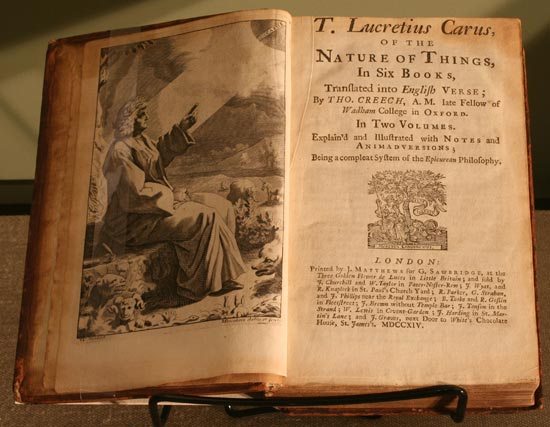
Of the Nature of Things, in Six Books, Titus Lucretius Carus (ca. 99–ca. 55 bc),
London: Printed by J. Matthews for G. Sawbridge, 1714
Lent by the Special Collections Library, University of Michigan Library
The front free endpapers of both volumes are inscribed "F. W. Kelsey. 1884." These
two volumes come from Kelsey's personal library.
Lucretius refused to recognize the immortality of the soul and promoted pleasure as the
ultimate aim of life. These ideas made the poem unacceptable to the medieval church, and even Renaissance
humanists were reluctant to admit the full implications of Lucretius's Epicureanism. Thus, throughout the
Middle Ages Lucretius received very little attention. English readers had to wait until 1656 when John
Evelyn (1620–1707) published the English translation of just book 1 of De rerum natura.
Then Thomas Creech (1659–1700) published a fully annotated translation in 1682. Our copy is an example
of a later edition of Creech's translation containing further commentaries and textual improvements.
-
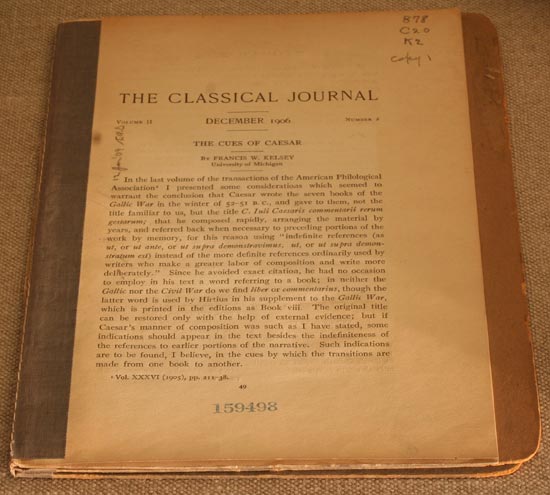
F. W. Kelsey, "The Cues of Caesar," The Classical Journal (1906)
Buhr Storage Facility, The University Library
-

Newspaper article
-

F. W. Kelsey, Caesar's Commentaries (1918)
This copy belonged to a student, Eugene S. Clarkson of Detroit.
Kelsey Museum Library
-
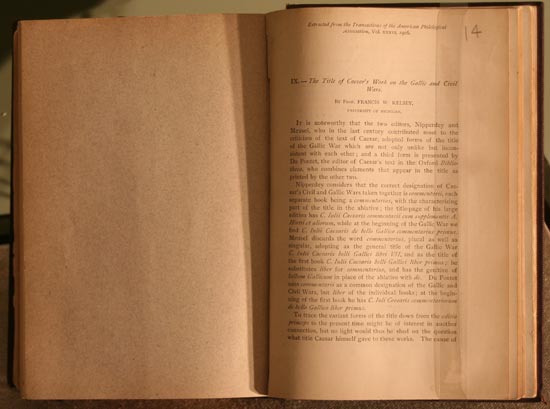
F. W. Kelsey, "The Title of Caesar's Work on the Gallic and Civil Wars,"
Transactions of the American Philological Association (1906)
Buhr Storage Facility, The University Library












